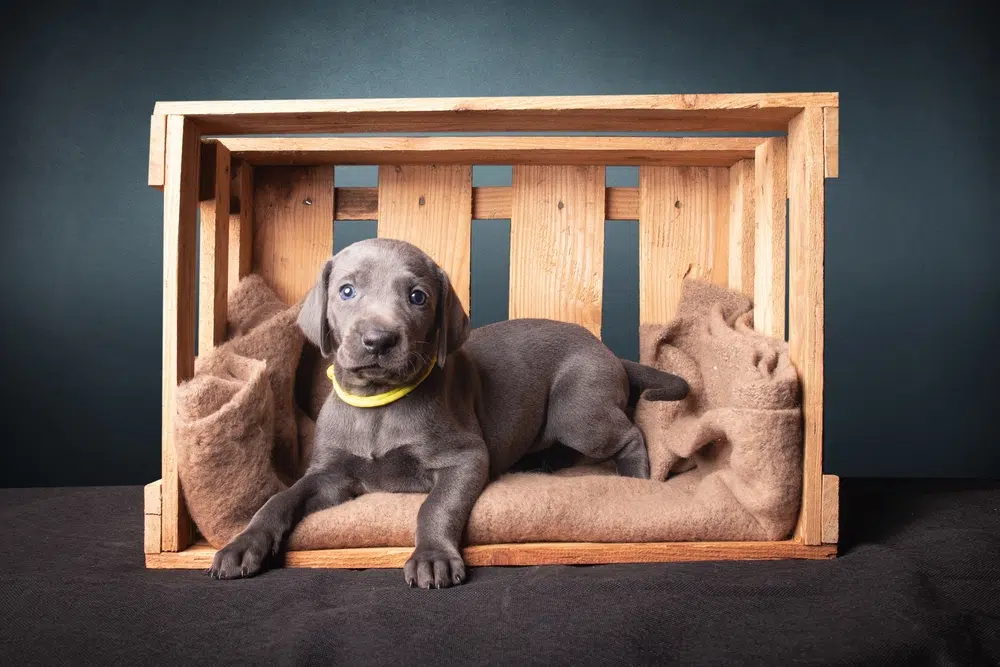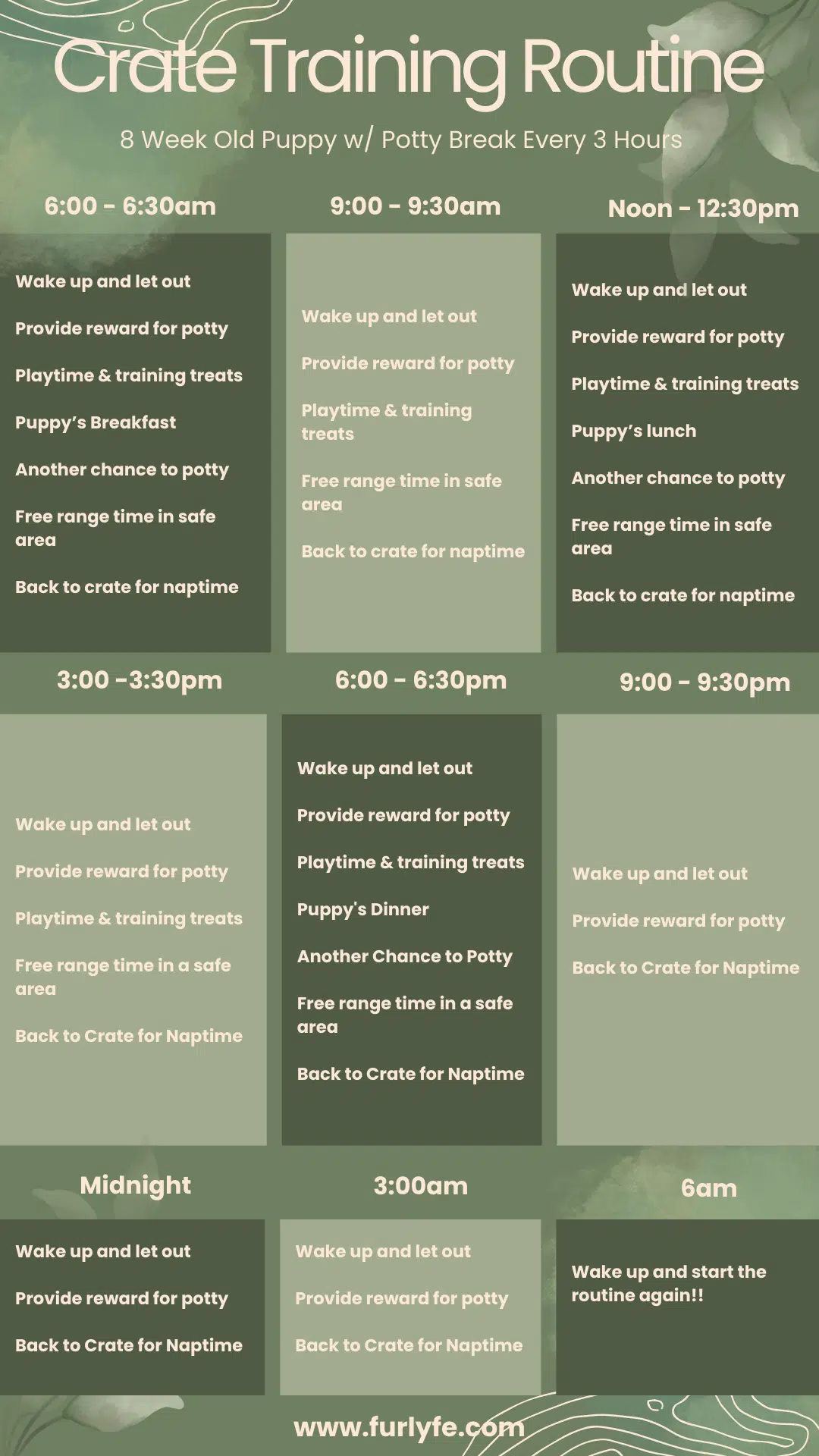Weimaraner Crate Training: A Complete Guide
Introduction to Weimaraner Crate Training
Weimaraners, a unique breed, often require specialized training techniques. One such method is crate training. This process, while sometimes misunderstood, is essential for both the dog and the owner.
Understanding the importance of crating for Weimaraners is crucial. It’s not just about confinement; it’s about creating a safe space. Understanding the Philosophy Behind Crate Training can provide deeper insights.
A well crate trained dog can prevent damages, ensure safety, and make vet visits or travels smoother. Moreover, the crate training process is beneficial for addressing separation anxiety, potty training and other behavioral issues.
Weimaraners have diverse personalities. Some may naturally take to crates, while others might need more time. It’s essential to recognize that Weimaraners are not one-size-fits-all. Addressing destructive behaviors early can prevent chewed up sofas or broken windows. Importance of Crate Training in a Weimaraner’s Life offers valuable insights into managing these behaviors.
11 Key Elements of Successful Crate Training:
- Understanding: Crating is humane and beneficial. It’s not a jail cell.
- Patience: Every Weimaraner puppy is different. Gradual introduction is key.
- Incorporation: The dog’s crate should be in the home’s central areas.
- Association: Make the crate a comfortable spot. Use cushions and shade.
- Routine: Incorporate crate time into daily routines. Consistency is crucial.
- Distraction: A frozen peanut butter filled kong can be a great distraction.
- Exhaustion: A tired dog is a happy dog. Ensure they’re worn out.
- Assistance: Sometimes, professional help might be needed.
- Medication: For extreme anxiety, consult a vet.
- Buddy System: Another dog can help, but it’s not always the solution.
- Acceptance: Some dogs might never fully adapt. It’s okay.
Understanding and accepting individual Weimaraner puppies and their quirks is essential. With patience and the right techniques, crate training can be a smooth process.
Part 2: Advanced Techniques and Considerations for Weimaraner Crating
Understanding the Weimaraner Breed
Weimaraners are a breed like no other. Their unique characteristics make them both a joy and a challenge to train.
Personality: Known for their affectionate nature, Weimaraners form deep bonds with their families. This attachment can lead to anxiety when separated if not addressed early.
Trainability: While they are intelligent and eager to please, their independent streak can sometimes make training a challenge. However, with consistent efforts, they can be trained effectively.
Energy Level: Weimaraners are high-energy dogs. This energy, if not channeled properly, can lead to destructive behaviors. Crating, combined with adequate exercise, can help manage this energy.
Size: Being a medium to large breed, choosing the right crate size is crucial. An appropriately sized crate ensures comfort and prevents the dog from using one end as a bathroom.
Navigating the Initial Days of Crate Training
From day one, crate training should be a priority. The first few days can be challenging, as the puppy adjusts to longer periods of solitude. Night crating is essential, but remember that young puppies might need nighttime potty breaks.
The Importance of Early Crate Training
Bringing home a Weimaraner puppy is a significant commitment. The crate should be introduced as a safe haven, minimizing potential accidents and deterring unwanted behaviors.
Setting Up the Perfect Crate Environment
Choosing a quiet area, like a laundry room or a corner in the living room, is essential. Promote independence by avoiding bedrooms. Ensure the crate’s size is appropriate, considering the Weimaraner’s growth.
Safety and Comfort Inside the Crate
Safety is paramount. Puppies, with their curious nature, might chew on dangerous items. The crate acts as a protective barrier. Introduce a few safe toys for engagement. Soft blankets or beds provide comfort, and a covered crate can offer a den-like feel.
Distinguishing Between Crate Training and Potty Training
While both are essential, they serve different purposes. A crate-trained dog might still have accidents if not potty trained. The crate aids in potty training by establishing a routine. For a comprehensive guide, refer to Detailed Guide on Potty Training Your Weimaraner.
Addressing Separation Anxiety
Given the Weimaraner’s strong bond with their owners, anxiety can be a concern. Proper crating, combined with gradual periods of separation, can help alleviate this anxiety.
Choosing the Right Crate
Choosing the right Crate is crucial. Different crates cater to different needs. Soft crates are portable but not ideal for unsupervised durations. Wire crates are versatile and perfect for growing Weimaraners. Plastic crates offer a den-like feel and are good for travel but can be bulky.
It is always best to have one dog per crate. If pup owners have multiples dogs they should plan on getting multiple crates for training. Each puppy needs their own safe space.
Male Weimaraners weigh between 70 to 85 pounds Female Weimaraners are slightly smaller, usually weighing between 55 to 70 pounds. Depending on gender, pet owners will want a large or X-large Crate. In order to adjust to your new puppy who’s rapid growing, it is a good idea to use dividers.
Understanding the Weimaraner’s unique traits is crucial for effective crate training. With patience, understanding, and the right techniques, crate training can be a rewarding experience for both the dog and the owner.
Part 3: Challenges and Solutions in Weimaraner Crate Training
Understanding the Weimaraner’s Nature
Weimaraners are a unique breed, known for their striking appearance and deep-rooted instincts. Historically bred for hunting, they are naturally pack animals. This means they thrive in groups and often seek the comfort and security of their human family. Their history as both hunting and companion dogs has ingrained in them a deep attachment to their owners, making them both loyal and sometimes overly dependent.
Challenges in Crate Training
Crating a Weimaraner presents its own set of challenges:
Separation Anxiety: Weimaraners are known for their strong bond with their owners. This bond, while beautiful, can lead to intense separation anxiety. If a Weimaraner is suddenly isolated or left alone, especially after being constantly surrounded by family, anxiety can manifest in various ways, from whining to destructive behaviors.
Destructive Behaviors: Without proper guidance and training, a bored or anxious Weimaraner might resort to unwanted behaviors. This can range from chewing on furniture, shoes, or other household items to more severe actions like trying to escape or showing aggression.
Misconceptions about the Crate: Some Weimaraners, especially if introduced to a crate later in life, might perceive it as a form of punishment. This perception can lead to resistance, making the training process more challenging.
Crate Training Process
Training your Weimaraner to accept and even love their crate is a process that requires patience, consistency, and understanding:
- Introducing the Crate: Start by positioning the crate in a family-centric area, such as the living room or laundry room. This allows the dog to feel included even when crated. Encourage your Weimaraner to explore the crate with the door open. Use treats, toys, or their favorite blanket to make the space inviting.
- Feeding Inside the Crate: One of the most effective ways to create a positive association with the crate is to serve their meals inside it. If your dog is hesitant, start by placing the food dish near the entrance and gradually move it further inside as they become more comfortable.
- Increasing Crate Duration: As your dog becomes more accustomed to the crate, you can begin to close the crate door for short durations. Start with just a few minutes and gradually extend this time, always ensuring they’re at ease and not showing signs of distress.
- Crating When You Leave: Once your dog can comfortably spend about 30 minutes in the crate without showing anxiety, you can start crating them when you leave the house for short periods. Ensure your departure and return are low-key to minimize potential anxiety triggers.
- Nighttime Crating: For many owners, nighttime crating is beneficial. Initially, consider placing the crate in your bedroom to offer comfort, especially for puppies. As they adjust and become more independent, you can move the crate to your preferred location. For more insights on this, Addressing Crate Fears in Weimaraners provides expert advice.
Below is a sample Crate Train Routine for an 8 week old puppy.
Solutions and Effective Crate Training Techniques
Successful crating is about more than just confinement. It’s about creating a positive, safe space for your Weimaraner:
Positive Reinforcement: Always reward your dog for entering the crate, whether with praise, treats, or toys. This reinforces the idea that the crate is a positive space.
Addressing Separation Anxiety: Gradually increase the periods of time your Weimaraner spends in the crate, especially when you’re home. This helps break the association of the crate with your absence and reduces anxiety.
Choosing the Right Crate: As your Weimaraner grows, their crate needs will change. Ensure the crate is spacious enough for them to stand, turn, and stretch, but not so large that they might use a corner as a bathroom.
Consistency: Like all training, consistency is crucial. Set a routine for crate time, ensuring your Weimaraner knows what to expect. This routine helps in establishing trust and comfort.
Understanding your Weimaraner’s unique traits and needs is crucial for effective crate training. With patience, understanding, and the right techniques, crating can be a rewarding experience for both the dog and the owner.
Part 4: Advanced Tips and Tricks for Successful Crate Training
Positive Associations in Crate Training
Weimaraners, like all dogs, respond well to positive associations, making it essential to leverage this understanding when crating. The role of positive reinforcement cannot be stressed enough. Consistent rewards shape behavior effectively, and this method of training is backed by proven psychological principles.
Treats serve as primary motivators in this process. It’s vital to choose treats that are both healthy and enticing for the dog, and the timing of giving these treats plays a crucial role in reinforcing desired behaviors.
Beyond treats, toys serve as more than just playthings. They act as both distractions and sources of comfort inside the crate. Regularly rotating these toys can keep a Weimaraner’s interest alive and well.
Furthermore, the emotional bond between the owner and the dog is strengthened through verbal praise and affection. It’s a delicate balance between offering tangible rewards like treats and toys and providing emotional rewards through praise.
Training Challenges Across Life Stages
Every life stage of a Weimaraner presents its own set of unique crating challenges. Puppies, with their inherent curiosity and occasional resistance, require a different approach. For them, it’s about making the crate a familiar and inviting space.
Adult Weimaraners, known for their independence, bring a different set of challenges to the table. It’s essential to understand their past experiences and behaviors to train them effectively. Senior Weimaraners, with age-related challenges, require adjustments in crating techniques to ensure their comfort and well-being.
Daily Integration of Crate Training
Integrating crating into the Weimaraner’s daily routines can significantly smoothen the process. Consistency is the backbone of successful training, and establishing regular routines can help reduce potential anxiety in the dog.
By integrating crate time with daily activities such as meals, playtime, and rest, the dog begins to associate the crate with positive experiences. Additionally, the strategic placement of the crate within the home ensures it remains an accessible and familiar space for the Weimaraner to spend time.
Addressing Setbacks in Training
However, like any training process, setbacks are natural. Understanding and addressing regressions requires identifying the root causes and employing tailored strategies for each unique challenge.
Behavioral challenges, such as excessive barking or whining, might sometimes necessitate seeking professional help or considering alternative training methods. It’s also crucial to recognize signs of stress, anxiety, or health-related issues in the dog and modify crating techniques to cater to these challenges.
Conclusion
Crate training a Weimaraner, like any dog, requires patience, consistency, and understanding. The benefits of successful crate training are manifold, offering safety, behavioral improvement, and a personal space for your dog.
It’s essential to approach the process with empathy, recognizing the unique characteristics and temperament of the Weimaraner breed. With the right techniques and a commitment to the process, crate training can lead to a harmonious living situation for happy dogs, where both the dog and owner feel secure and content.
Frequently Asked Questions (FAQs)
Why is my Weimaraner resistant to the crate?
- Initial resistance is common. It’s about unfamiliarity. Gradual introduction and positive reinforcement help.
How long should I crate train my Weimaraner each day?
- Start with short periods, gradually increasing. Consistency is more crucial than duration.
Is it okay to crate my Weimaraner at night?
- Yes, but ensure the crate is comfortable. Night-time crating can establish a routine.
What should I do if my Weimaraner shows signs of separation anxiety?
- Recognize the signs early. Use toys, gradual training, and consult a professional if needed.
How can I make the crate more comfortable for my Weimaraner?
- Use soft bedding, familiar toys, and ensure it’s the right size. Comfort is key to successful training.




















Get involved!
Comments